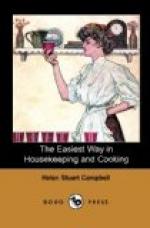FISH forms the only animal food for a large part of the world. It does not possess the satisfying or stimulating properties belonging to flesh, yet the inhabitants of fishing-towns are shown to be unusually strong and healthy. The flesh of some fish is white, and of others red; the red holding much more oil, and being therefore less digestible. In Salmon, the most nutritious of all fishes, there are, in a hundred parts, sixteen of nitrogen, six of fat, nearly two of saline matter, and seventy-seven of water. Eels contain thirteen parts of fat. Codfish, the best-known of all the white fish, vary greatly, according to the time of year in which they are taken, being much more digestible in season than out (i.e., from October to May). Mackerel and Herring both abound in oil, the latter especially, giving not only relish to the Irishman’s potato, but the carbon he needs as heat-food. Shell-fish are far less digestible, the Oyster being the only exception. The nitrogenous matter in oysters is fourteen parts, of fatty matter one and a half, of saline matter two, and of water eighty. At the time of spawning—from May to September—they lose their good condition, and become unwholesome. Lobsters rank next in importance, and are more delicate and finer-flavored than Crabs. Both are, however, very difficult of digestion, and should only be used occasionally. The many forms of pickled and smoked fish are convenient, but always less wholesome than fresh.
MILK comes next, and has already been considered in a previous chapter. It is sometimes found to disagree with the stomach, but usually because looked upon as drink and not as real food, the usual supply of which is taken, forgetful of the fact that a glass or two of milk contains as much nourishment as two-thirds of the average meal. The nitrogenous matter in milk is known as caseine, and it is this which principally forms cheese.
CHEESE is commonly considered only a relish, but is in reality one of the most condensed forms of nitrogenous food; and a growing knowledge of its value has at last induced the Army Department to add it to the army ration list. Mattieu Williams, after giving the chemical formulas of caseine and the other elements of cheese, writes; “I have good and sufficient reasons for thus specifying the properties of this constituent of food. I regard it as the most important of all that I have to describe in connection with my subject,—The Science of Cookery. It contains, as I shall presently show, more nutritious material than any other food that is ordinarily obtainable, and its cookery is singularly neglected,—practically an unknown art, especially in this country. We commonly eat it raw, although in its raw state it is peculiarly indigestible, and in the only cooked form familiarly known among us here, that of Welsh rabbit or rare-bit, it is too often rendered still more indigestible, though this need not be the case.




